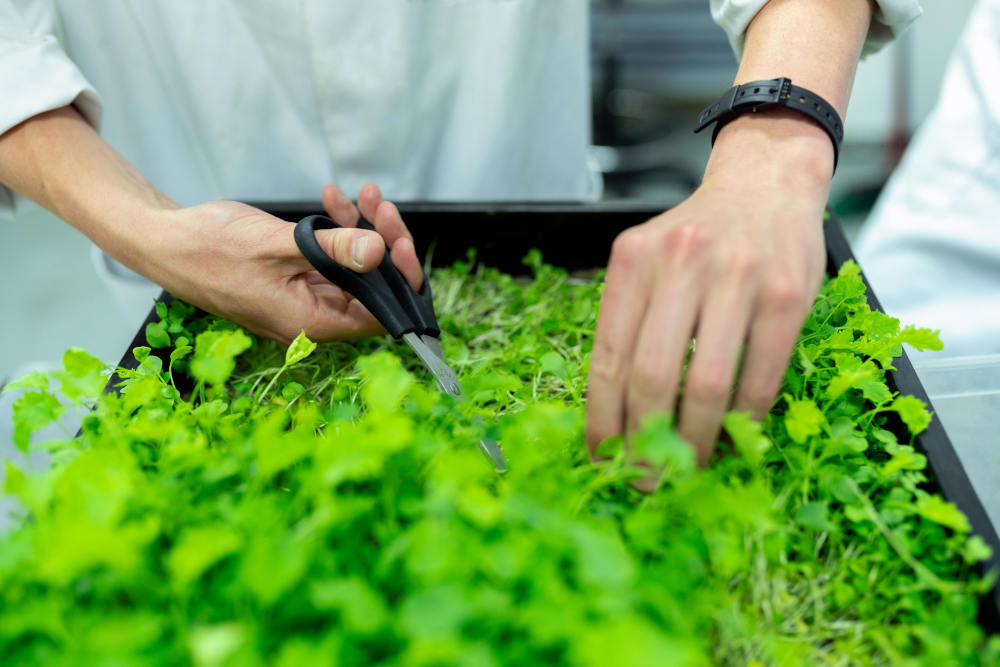
Cultiver des herbes aromatiques en intérieur permet de profiter d'une saveur fraîche et d'un soin naturel à portée de main, même lorsque les conditions extérieures sont difficiles ou irrégulières. Mais l'un des principaux défis des jardiniers d'intérieur est le manque de soleil, surtout pendant les journées plus courtes de l'hiver ou dans les maisons où la lumière naturelle est limitée. La solution ? Des lampes de culture artificielles .
Que vous semiez, entreteniez un potager ou cultiviez des herbes aromatiques toute l'année en intérieur, un éclairage artificiel adapté peut favoriser l'épanouissement de vos plantes. Dans ce guide complet, vous apprendrez à cultiver vos herbes aromatiques en intérieur avec des lampes de culture, du choix de la configuration d'éclairage au choix des meilleures herbes pour la culture en intérieur.
Panaprium est indépendant et pris en charge par les lecteurs. Si vous achetez quelque chose via notre lien, nous pouvons gagner une commission. Si vous le pouvez, veuillez nous soutenir sur une base mensuelle. La mise en place prend moins d'une minute et vous aurez un impact important chaque mois. Merci!
Pourquoi cultiver des herbes à l’intérieur avec une lumière artificielle ?
Voici les principaux avantages de la culture d’herbes en intérieur à l’aide de lampes de culture :
-
Herbes fraîches toute l'année : cultivez du basilic, de la menthe, du thym et bien plus encore, quelle que soit la saison ou la météo.
-
Environnement contrôlé : évitez les parasites, les variations de température et les arrosages irréguliers.
-
Gain de place : utilisez les comptoirs de cuisine, les rebords de fenêtre ou les étagères dédiées aux plantes.
-
Idéal pour les petites maisons ou appartements : même sans espace jardin extérieur.
Mais pour réussir en intérieur, la lumière est essentielle. La plupart des herbes aromatiques ont besoin d'au moins 6 à 8 heures de plein soleil , et peu de fenêtres offrent ce niveau de luminosité de manière constante. Les lampes de culture artificielles complètent ou remplacent la lumière du soleil et assurent aux herbes l'énergie nécessaire à la photosynthèse et à la croissance.
Comment fonctionnent les lampes de culture ?
Les lampes de culture reproduisent le spectre lumineux naturel du soleil, fournissant les longueurs d'onde essentielles à la photosynthèse des plantes, principalement dans les spectres bleu et rouge . La lumière bleue favorise la croissance des feuilles, tandis que la lumière rouge favorise la floraison et le développement général.
De nombreuses lampes LED à spectre complet combinent les deux, prenant en charge toutes les étapes de la croissance des herbes.
Types de lampes de culture pour herbes d'intérieur
Il existe plusieurs types de lampes de culture, chacune ayant des avantages et des inconvénients :
1. Lampes de culture à LED (diodes électroluminescentes)
-
Meilleur choix pour les herbes.
-
Économe en énergie, faible dégagement de chaleur, longue durée de vie (jusqu'à 50 000 heures).
-
Disponible dans des options à spectre complet pour une croissance équilibrée.
-
Idéal pour les espaces compacts ou les configurations d'étagères.
Exemple : Panneaux de culture LED à spectre complet ou bandes lumineuses.
2. Lampes fluorescentes (tubes CFL ou T5/T8)
-
Abordable et largement disponible.
-
Produit une chaleur minimale, idéal pour les petites installations d'herbes.
-
Les luminaires T5 offrent une meilleure intensité que les ampoules CFL.
-
Légèrement moins efficace que la LED, durée de vie plus courte.
Exemple : luminaires T5 à haut rendement (HO) pour racks de démarrage de graines.
3. Ampoules de culture à incandescence
-
Non recommandé pour les herbes.
-
Produire trop de chaleur et pas assez de lumière utilisable.
-
Le moins efficace et la durée de vie la plus courte.
Verdict : pour les herbes, les lampes de culture à LED sont idéales en raison de leur efficacité énergétique, de leur longue durée de vie et de leur rendement lumineux équilibré.
Choisir la bonne configuration d'éclairage de culture
Votre configuration idéale dépend de l’espace, du budget et du nombre d’herbes que vous souhaitez cultiver.
À petite échelle : installation sur un comptoir ou un bureau
-
Type d'éclairage : ampoule de culture LED dans une lampe à pince ou une lampe de culture de bureau.
-
Idéal pour : 2 à 4 plantes aromatiques (basilic, thym, ciboulette, menthe).
-
Conseil : maintenez la lumière à 15 à 30 cm au-dessus du sommet des plantes.
Échelle moyenne : jardin sur étagères ou sur support
-
Type d'éclairage : bandes lumineuses LED ou barres lumineuses de culture T5.
-
Idéal pour : 6 à 12 herbes sur des étagères à plusieurs niveaux.
-
Astuce : utilisez des chaînes ou des étagères réglables pour modifier la distance lumineuse à mesure que les plantes poussent.
À grande échelle : tour ou tente de jardin intérieur
-
Type d'éclairage : panneau de culture LED avec minuterie.
-
Idéal pour : les cultivateurs d'herbes aromatiques d'intérieur sérieux ou les jardiniers urbains.
-
Astuce : utilisez des murs réfléchissants pour maximiser la couverture lumineuse.
De combien de lumière les herbes ont-elles besoin ?
La plupart des herbes culinaires ont besoin de 12 à 16 heures de lumière par jour pour bien pousser à l’intérieur.
Voici un guide rapide :
| Herbe | Besoins en lumière | Notes |
|---|---|---|
| Basilic | 14 à 16 heures | A aussi besoin de chaleur |
| Persil | 12 à 14 heures | Croissance lente mais robuste |
| coriandre | 12 à 14 heures | Températures plus fraîches préférées |
| Thym | 12 heures | Croissance compacte |
| Origan | 12 à 14 heures | Mimétisme du plein soleil |
| Menthe | 12 à 14 heures | Se propage rapidement |
| ciboulette | 12 heures | Idéal pour les rebords de fenêtre |
| Sage | 12 heures | Aime une bonne circulation d'air |
Utilisez une minuterie pour assurer des cycles lumineux réguliers. Automatiser les heures d'allumage et d'extinction améliore la croissance et vous évite d'avoir à vous en souvenir quotidiennement.
Choisir les meilleures herbes à cultiver en intérieur sous lumière
Certaines herbes aromatiques s'adaptent mieux que d'autres aux environnements intérieurs. Commencez par ces variétés performantes :
1. Basil
-
Aime la chaleur et la lumière.
-
Nécessite 14 à 16 heures de lumière et une taille régulière.
-
Idéal pour le pesto, les salades et les sauces.
2. Ciboulette
-
Rustique et compact.
-
Saveur douce d'oignon.
-
Excellent pour les œufs, les soupes et les garnitures.
3. Menthe
-
Très adaptable et à croissance rapide.
-
À utiliser dans les thés, les desserts et les plats salés.
-
Nécessite une taille régulière pour éviter l'encombrement.
4. Persil
-
Prend du temps à pousser mais se porte bien avec la lumière.
-
Variétés à feuilles plates (italiennes) ou frisées.
-
Parfait pour garnir et aromatiser les soupes.
5. Thym
-
Petit et persistant.
-
Résistant à la sécheresse, il prospère avec une lumière modérée.
-
Idéal pour les rôtis, les légumes et les marinades.
6. Origan
-
Herbe au goût prononcé pour les plats italiens et grecs.
-
Se plaît dans les espaces chauds et bien éclairés.
-
Croissance compacte avec récolte régulière.
7. Coriandre
-
Herbe de saison fraîche aux feuilles délicates.
-
Nécessite un bon drainage et une lumière modérée.
-
Idéal pour les salsas, les currys et les garnitures.
Planter et cultiver des herbes aromatiques à l'intérieur avec des lumières
Suivez ces étapes pour un jardin d’herbes aromatiques d’intérieur productif :
1. Choisissez les bons contenants
-
Utilisez des pots avec des trous de drainage.
-
Les contenants de 4 à 6 pouces sont parfaits pour les plantes individuelles.
-
Les jardinières ou plateaux à herbes avec compartiments conviennent parfaitement aux herbes mélangées.
2. Utilisez un terreau de qualité
-
Choisissez un terreau biologique et non de la terre de jardin.
-
Un sol léger et bien drainé favorise des racines saines.
-
Pensez à ajouter de la perlite ou de la fibre de coco pour une meilleure aération.
3. Arrosez intelligemment
-
Arrosez lorsque le premier centimètre du sol est sec.
-
Évitez de trop arroser : les herbes n’aiment pas les racines détrempées.
-
Utilisez des soucoupes pour récupérer l’excès d’eau.
4. Nourrissez régulièrement
-
Utilisez un engrais liquide organique équilibré toutes les 2 à 4 semaines.
-
Les herbes d’intérieur peuvent épuiser leurs nutriments plus rapidement en raison du sol confiné.
5. Taillez et récoltez souvent
-
Une récolte régulière favorise une nouvelle croissance.
-
Coupez toujours avec des ciseaux propres juste au-dessus d'un nœud de feuille.
-
Ne retirez pas plus d’un tiers de la plante à la fois.
Dépannage des problèmes courants
Même avec de la lumière artificielle, des problèmes peuvent survenir. Voici quelques solutions rapides :
| Problème | Cause | Solution |
|---|---|---|
| Croissance des longues jambes | Lumière trop éloignée ou insuffisante | Réduire la luminosité ou augmenter les heures |
| Feuilles jaunies | Arrosage excessif ou mauvais drainage | Laissez sécher le sol, rempotez si nécessaire |
| Croissance lente | Trop peu de lumière ou de nutriments | Ajuster le programme d'éclairage, nourrir la plante |
| Sol moisi | Mauvaise circulation d'air ou excès d'humidité | Utilisez un ventilateur, réduisez la fréquence d'arrosage |
Conseils avancés pour réussir
-
Faites pivoter les plantes chaque semaine pour favoriser une croissance uniforme sous la lumière.
-
Utilisez des surfaces réfléchissantes comme du mylar ou des tableaux blancs pour renvoyer la lumière.
-
Regroupez les herbes en fonction de leurs besoins : séparez les herbes qui aiment l’humidité (menthe, persil) des types qui tolèrent la sécheresse (thym, romarin).
-
Surveillez la température : la plupart des herbes aromatiques poussent entre 18 et 24 °C. Évitez les courants d'air et les bouches de chauffage.
Réflexions finales
Pas besoin d'une fenêtre ensoleillée ni d'un grand jardin pour cultiver des herbes aromatiques. Grâce à l'éclairage artificiel, profitez d'un jardin d'herbes aromatiques intérieur florissant toute l'année , quel que soit l'espace disponible ou la saison. Que vous souhaitiez quelques pots de basilic et de ciboulette sur votre plan de travail ou une étagère remplie d'herbes aromatiques variées, l'éclairage artificiel vous offre le contrôle et la constance nécessaires pour cultiver des herbes aromatiques luxuriantes et savoureuses en intérieur.
Commencez petit, investissez dans une lampe de culture LED de bonne qualité et voyez votre jardin d'intérieur se transformer. Avec un peu d'attention, vous n'aurez plus jamais besoin d'acheter des herbes aromatiques en magasin.
Cet article vous a-t-il été utile ? S'il vous plaît dites-nous ce que vous avez aimé ou n'avez pas aimé dans les commentaires ci-dessous.
About the Author: Alex Assoune
Contre Quoi Nous Luttons
Les groupes multinationaux surproduisent des produits bon marché dans les pays les plus pauvres.
Des usines de production où les conditions s’apparentent à celles d’ateliers clandestins et qui sous-payent les travailleurs.
Des conglomérats médiatiques faisant la promotion de produits non éthiques et non durables.
De mauvais acteurs encourageant la surconsommation par un comportement inconscient.
- - - -
Heureusement, nous avons nos supporters, dont vous.
Panaprium est financé par des lecteurs comme vous qui souhaitent nous rejoindre dans notre mission visant à rendre le monde entièrement respectueux de l'environnement.
Si vous le pouvez, veuillez nous soutenir sur une base mensuelle. Cela prend moins d'une minute et vous aurez un impact important chaque mois. Merci.































0 commentaire